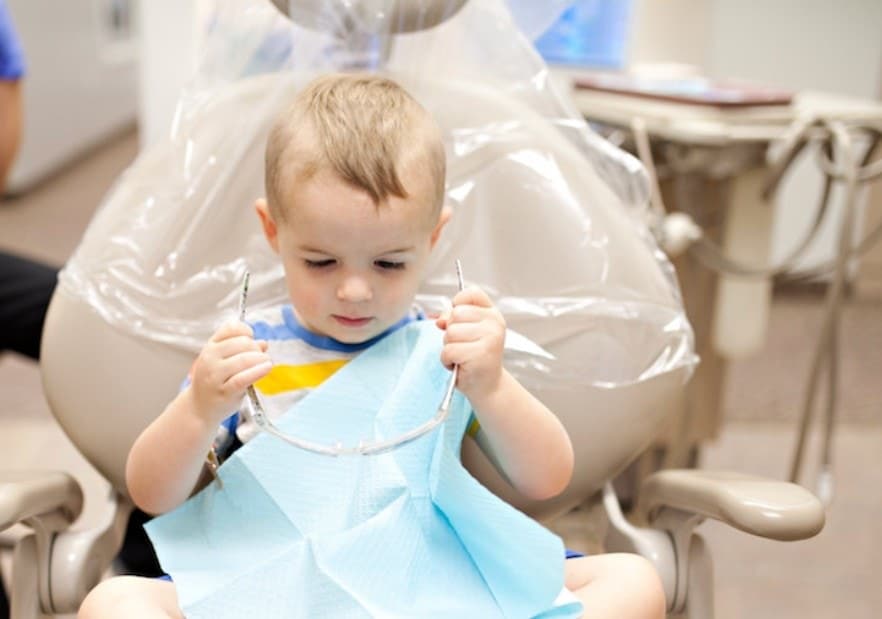When to schedule your baby’s first dentist appointment

Spoiler: It's probably earlier than you think.
Table of Contents
Ask any new parent when their child’s first trip to the pediatrician should be, and they’ll say, “The first visit to the doctor should be right away!” And they’ll be right. Many new parents schedule this first visit shortly after giving birth.
But if you ask the same parent when their child’s first trip to the dentist should be, they might not be quite as sure.
When to make baby’s first dentist appointment
Both the American Academy of Pediatric Dentistry (AAPD) and the American Academy of Pediatrics (AAP) recommend scheduling baby’s first dentist appointment no later than their first birthday.
The AAP has been recommending this standard since 2003, though most patients tell me that their pediatricians are unaware of this decade-old guideline for dental care.
If you haven’t taken your child to the dentist by 12 months of age, you are not alone. A 2015 study showed that only 1 percent of almost 95,000 children had their first dental visit by age one. And a 2018 poll found that 1 in 6 parents didn’t know when to schedule a child’s first dentist appointment.
Your baby’s first dentist appointment is an opportunity to establish a “dental home” for your child, which the AAPD defines as an “ongoing relationship between the dentist and the patient, inclusive of all aspects of oral health care delivered in a comprehensive, continuously accessible, coordinated, and family-centered way.” Much like a medical home, your child’s dental home will be a consistent anchor for their general health throughout their childhood.
An early dentist visit is also a chance to recognize, diagnose and hopefully prevent dental cavities. Although preventable, dental cavities are the most common chronic disease of childhood, according to the CDC—four times as prevalent as asthma. Studies show that earlier visits to the dentist result in fewer future cavities—and fewer treatment costs.
But there are many other things to look for in a child’s mouth besides cavities.
What to expect at baby’s first dentist appointment
At your child’s first appointment, a dentist will provide a comprehensive examination of his entire mouth. That means we don’t just look at the teeth, but also the gums, soft tissues of the mouth, the developing jaws—we even assess the child’s airway. And of course, the dentist or hygienist will also perform a dental cleaning and, if appropriate for your child, will apply fluoride to prevent cavities from developing.
A parent’s guide to the first dentist appointment
One of the most important parts of these early dental appointments is also parental education. Your dentist may ask you how much juice your child drinks, or if she falls asleep with a bottle, sucks his thumb or uses a pacifier, and how often.
Other topics your child’s dentist will most likely want to discuss with you:
- Proper oral hygiene at home
- Dietary recommendations to help prevent cavities
- Stopping “non-nutritive” oral habits, like pacifier use
- How to placate a teething child
- Differences in fluoride levels of municipal, well, and bottled waters
- How the development of the mouth affects speech patterns
- When baby teeth should fall out and permanent teeth come in
- What to do in cases of dental trauma
- How to recognize sleep apnea in children
While this certainly isn’t an exhaustive list of what the first appointment could involve, the main goal of this visit is to provide your child with an enjoyable first dental experience and help you feel empowered as a parent to keep your child’s mouth healthy.
If you haven’t done so already, now is the time to schedule your child’s first dental appointment.
After making that first appointment, to prepare your child for their first visit, the most important thing you can do is start talking positively about the dentist. Children with fears about dentists usually learn those fears from adults.
Children’s brains are like sponges, and they are good at picking up on cues. Show your kids that you like going to the dentist. Take them with you when you go. Sit them down on your lap in the dentist’s chair. And smile!
A version of this post was originally published in 2017; it has been updated.


































